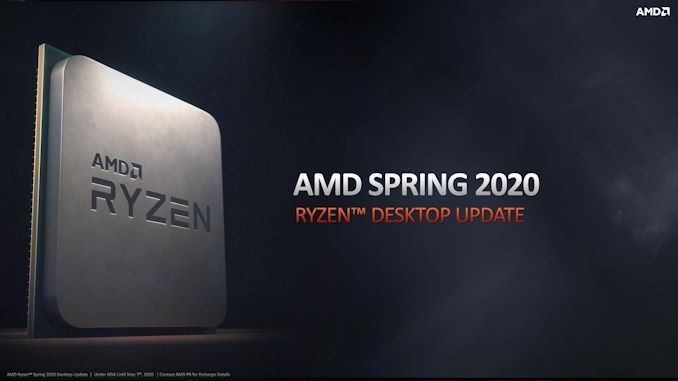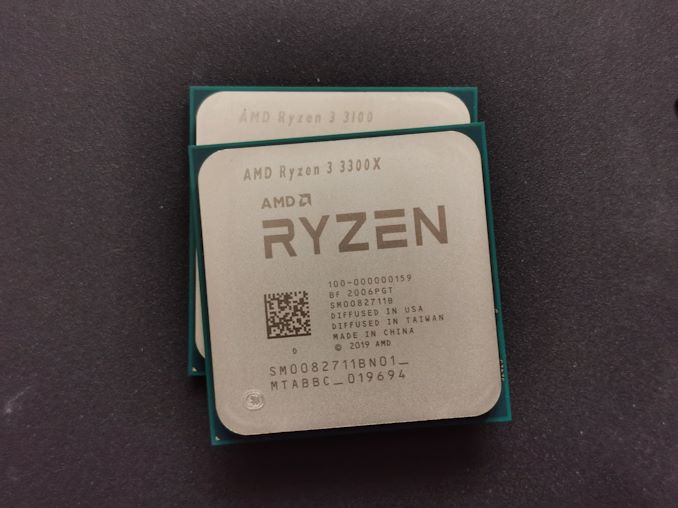The AMD Ryzen 3 3300X and 3100 CPU Review: A Budget Gaming Bonanza
by Dr. Ian Cutress on May 7, 2020 9:00 AM ESTThe Battering Ram of Time
A wouldn’t say a lot, but at least some discussion has been permeating through the airwaves since the Ryzen 3000 desktop launch as to what AMD was going to do in its sub-$200 space. Not having a latest generation product in a very active part of the market was missing from the portfolio, but initially AMD was happy for its previous generation CPUs and APUs to fill that role.
There were two schools of thought. The first is that AMD would launch lower core count CPUs, despite having a supposedly high yielding chiplet design that was going straight into its highest margin server product portfolio. Building a low core count chiplet design also incurs the added cost of bringing a chiplet and an IO die together in packaging, further decreasing margins. It seemed unlikely at the time.
The second school of thought would be that AMD would populate this part of the market with desktop versions of the Ryzen 4000 mobile APUs. These monolithic parts had integrated graphics, and would very likely easily scale from 45 W to 65 W for the desktop. Like previous APUs there would only be 8 PCIe lanes for external graphics, but for this generation also only PCIe 3.0 due to how the mobile APUs were powered.
Personally I assumed the second one, and that AMD would ignore the CPUs and go straight in for the APUs. I was perhaps unprepared for the apparent success of AMD’s mobile chips in the laptop space. We’ve reviewed the ASUS Zephyrus G14, a true flagship AMD notebook, and the Acer Swift 3, offering mind-bending performance and quality for the price. AMD is promoting 100+ design wins on Ryzen Mobile in 2020, global pandemic permitting, and the OEMs are jumping on the bandwagon it seems.
As we’ve shown in the review, this means that we get some CPUs. The Ryzen 3 3300X and Ryzen 3 3100 are odd elements to the Ryzen family, especially the 3100 with its awkward CCX and core configuration, but both parts offer a lot of performance for their pricing. At $120 and $99 respectively, using AMD’s latest Zen 2 microarchitecture and the power efficient 7nm TSMC process, AMD is defining a new baseline in budget performance.
This is personified in very much in comparing the AMD Ryzen 3 3300X to Intel’s flagship consumer processor from 2017.
Three years and four months ago at CES, Intel launched to great fanfare its Kaby Lake processor family, with the Core i7-7700K sitting atop of the stack. This quad core Skylake-based chip offered frequency bumps from the previous gen, and better gaming performance in a 91 W package. Its 4.2 GHz base frequency, 4.5 GHz turbo frequency, DDR4-2400 memory support and 16 PCIe 3.0 lanes were the talk of the down. All this could be yours for $350.
Then push forward a short time to today, and the Ryzen 3 3300X. This is also a quad core processor, built with Zen 2 cores at a lower frequency: only 3.8 GHz base and 4.3 GHz turbo. There’s faster memory in DDR4-3200, more and faster 24 PCIe 4.0 lanes, and is rated only at 65 W. For almost one third of the price, at $120.
Cue the roundup results.
| Benchmark Comparison Ryzen 3 3300X vs i7-7700K at 100% |
|||
| AnandTech | Ryzen 3 3100 |
Ryzen 3 3300X |
Core i7-7700K |
| Web | 121% | 138% | 100% |
| System | 99% | 112% | 100% |
| Encoding | 105% | 115% | 100% |
| Rendering | 98% | 111% | 100% |
| Synthetics | 103% | 110% | 100% |
| Dwarf Fortress | 86% | 95% | 100% |
| Legacy | 96% | 105% | 100% |
| Gaming | 99% | 105% | 100% |
I’m pretty sure prices of used Kaby Lake CPUs are about to crash. They’re going to have to fall a long, long way though.
It's at this time I should point out that Intel obviously has newer quad cores on offer. The 9th Generation Core i3 parts are quad core with no hyperthreading, but still running a variant of the Skylake microarchitecture, albeit at a higher frequency. The Core i3-9100 for example is a 4C/4T part with a base of 3.6 GHz and turbo of 4.2 GHz, and a TDP of 65W, for $120. It still only has PCIe 3.0 and DDR4-2400 however, so it would likely perform worse than the i7-7700K. Even with this, Intel's ability to provide enough stock of these low-end parts, depending on your location, is questionable as previously mentioned. Case in point: the comapny never even made it as far as sampling any of the 9th Generation i3 parts for review.
Intel has announced the 10th Generation Comet Lake processors, coming later this month, and the Core i3 parts there will offer hyperthreading. The Core i3-10100 is a 4C/8T part with a 3.6 GHz base and a 4.3 GHz turbo, with a 65 W TDP for $120. It still only has PCIe 3.0, but supports DDR4-2666, compared to AMD supporting PCIe 4.0 and DDR4-3200. When these are available at retail, we should put it up against the 3300X to see who wins.
All that being said, AMD still has two issues to sort out with the new Ryzen 3 parts. The idle power seems high at 18 W, and B550 motherboards need to exist to make these Ryzen 3 processors more attractive for system builds. The latter should come around soon, and we’ll have additional coverage there.
At the end of the day, if you are the sort of person that enjoys waiting a couple of years to get games 95% off on Steam, the 3300X is your processor. Those AAA titles are calling.












249 Comments
View All Comments
Ian Cutress - Thursday, May 7, 2020 - link
4790K 6700K 7700KAll Intel quad core showing generational differences as to where the 3300X and 3100 fit in.
1600X, 1700, 1700X, 1800X are all in our benchmark database, Bench.
It's practically listed on almost every page.
notb - Thursday, May 7, 2020 - link
And that's obviously great. But with that approach you could just write "3100 and 3300X added to Bench", right? :)I have nothing against the factual layer of this article. Results are as expected and they look consistent.
But it's essentially a story how an entry-level $120 CPU from company A beats a not-so-ancient flagship from company B.
So I'm merely wondering why you decided to write it like this, instead of comparing to wider choice of expensive CPUs from 2017. Because in many of your results 3300X beats 1st gen Ryzens that were even more expensive than the 7700K.
Or you could include older 4C/8T Ryzens (1500X) - showing how much faster Zen2 is.
Instead you've included the older 6-core Ryzens, which are neither similar in core count nor in MSRP.
Ian Cutress - Friday, May 8, 2020 - link
2600/1600 AF is ~$85 at retail (where you can find it), and judging by the comments, VERY popular. That's why this was included.Deicidium369 - Friday, May 8, 2020 - link
Just say AMD GOOD! INTEL BAD! that's all they are looking foreastcoast_pete - Thursday, May 7, 2020 - link
Some other sites have, and yes, the 3300 gives most of the 1st generation Ryzens a run for their money.Irata - Thursday, May 7, 2020 - link
This is a highly impressive little CPU for the money.I particularly liked the 3300X‘s good showing. If this is at least in part due to it using only one CCX, this should bode well for Ryzen 3 which should have an eight core CCX.
Look at some tests were Ryzen did not do so well wrt their Intel counterpart like Kraken and Octane - the 3300x now does very well. It even scores slightly better than the 3700x
wr3zzz - Thursday, May 7, 2020 - link
Does the B550 MB need active cooling? I can't tell from the pic.callmebob - Thursday, May 7, 2020 - link
Look at the spec graphics. Note the only difference to the old B450 is pretty much that it provides PCIe 3.0 lanes instead of PCIe 2.0.Now, when was the last time you saw a PCIe 3.0-based chipset hub needing active cooling?
As an aside, while i am kinda glad the B550 is finally coming, i am also a bit disappointed in seeing AMD (and their design/manufacturing partners) needing a better part of a year just for managing a bump from PCIe 2.0 to PCIe 3.0. PCIe 3.0 has been in the market for around eight years now; there is no excuse for AMD taking this long to figure out this s*it.
Fritzkier - Thursday, May 7, 2020 - link
Because their PCIe 3 and 4 was provided by the CPU tho. Or maybe there's an advantage of PCIe lanes provided by the chipset?callmebob - Thursday, May 7, 2020 - link
Haha, do you even know _how many_ PCIe lanes the CPU provides? Wager a guess whether it is for more than a single x16 slot?